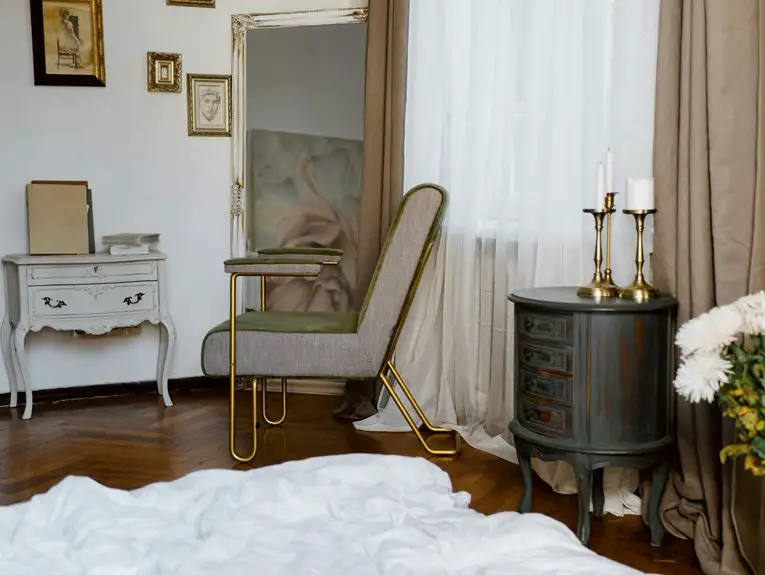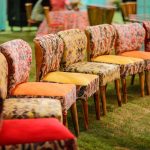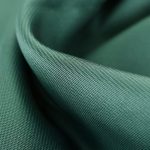To clean mildew off your fabric lawn furniture, start by mixing equal parts white vinegar and water in a spray bottle. Spray the solution generously on mildewed areas, let it sit for 10-15 minutes, then gently scrub with a soft brush before rinsing thoroughly with water. Make sure to air dry your furniture in sunlight to prevent mildew from returning. Using gentle cleaning and drying methods helps preserve your fabric’s life. Keep exploring to discover how to tackle stubborn stains and prevent mildew altogether.
Table of Contents
Key Takeaways
- Mix equal parts white vinegar and water, spray on mildew, let sit 10-15 minutes, then gently scrub and rinse thoroughly with water.
- Use gloves, goggles, and a mask to protect from fumes and prevent skin and eye contact during cleaning.
- Rinse fabric with a gentle hose spray, avoid high pressure, then blot excess water and air dry completely in sunlight.
- Regularly clean and dry furniture, store in a dry, ventilated area, and use breathable covers to prevent mildew growth.
- Test cleaning solutions on a small hidden spot first to ensure fabric safety and avoid discoloration or damage.
Understanding Mildew on Fabric Lawn Furniture
Although mildew may seem harmless at first, it can quickly damage your fabric lawn furniture if left untreated. You’ll notice mildew as those fuzzy, grayish spots that thrive in damp, shaded areas.
It’s a type of fungus that feeds on organic matter, like the fibers in your cushions and covers. If you ignore it, mildew weakens the fabric’s integrity, causing discoloration and unpleasant odors. You might also find that it becomes harder to remove over time.
Mildew grows best in humid environments, so keeping your furniture dry is key to prevention. Recognizing mildew early lets you act quickly, protecting your investment and maintaining your outdoor space’s appearance.
Understanding this helps you tackle the problem confidently before it gets worse.
Essential Tools and Materials Needed
To tackle mildew on your fabric lawn furniture, you’ll need the right cleaning solutions, like mild detergent or a vinegar mixture.
Don’t forget protective gear such as gloves and a mask to keep yourself safe.
Grab some soft brushes and cloths to gently scrub and care for the fabric without causing damage.
Cleaning Solutions Options
Choosing the right cleaning solution is essential for effectively removing mildew from fabric lawn furniture without damaging the material.
You can start with a simple mix of mild dish soap and warm water, which works well for light mildew stains. For tougher spots, a solution of one part white vinegar to four parts water is both natural and effective.
Alternatively, mixing a tablespoon of baking soda with water creates a gentle abrasive paste that lifts mildew safely. If mildew is stubborn, a diluted bleach solution (one part bleach to ten parts water) can be used cautiously, but test a small hidden area first to avoid discoloration.
Always use fresh solutions and avoid harsh chemicals that could degrade the fabric fibers or cause fading.
Protective Gear Essentials
Before you start cleaning mildew off your fabric lawn furniture, make sure you have the right protective gear on hand. Wearing proper protection keeps you safe from harsh cleaners and mold spores. Gloves prevent skin irritation, goggles shield your eyes, and a mask protects your lungs from airborne mildew particles. Long sleeves and pants help protect your skin from splashes.
Here’s a quick guide to essential protective gear:
| Gear | Purpose | Tips |
|---|---|---|
| Gloves | Protect hands from chemicals | Use waterproof gloves |
| Goggles | Shield eyes from splashes | Choose snug-fitting |
| Mask | Filter mildew spores | Use an N95 or better |
| Long Clothing | Prevent skin contact | Wear old, comfortable |
Tools for Fabric Care
A few essential tools and materials will make cleaning mildew off your fabric lawn furniture much easier and more effective.
Start with a soft-bristle brush to gently scrub the fabric without damaging it. You’ll also need a spray bottle for applying your cleaning solution evenly.
Have a bucket handy for mixing water with mild detergent or vinegar. Use white cloths or sponges to blot and wipe away mildew residue.
A garden hose with a gentle spray setting helps rinse the fabric thoroughly. Don’t forget gloves to protect your hands and a mask if you’re sensitive to mold spores.
Finally, keep a clean towel nearby to absorb excess moisture and speed up drying.
With these tools ready, you’ll tackle mildew efficiently and keep your furniture looking fresh.
Preparing the Furniture for Cleaning
Start by moving your fabric lawn furniture to a well-ventilated area where you can work comfortably without worrying about dampness or dirt.
Next, remove any loose cushions or removable fabric pieces to clean separately.
Use a soft brush or vacuum with an upholstery attachment to gently eliminate dust, dirt, and debris from the fabric surface.
Check the furniture tags for any specific cleaning instructions or warnings.
If possible, test a small, hidden area with your chosen cleaning approach to verify it won’t damage or discolor the fabric.
Finally, gather all necessary cleaning tools and materials nearby so you can work efficiently.
Preparing your furniture this way sets the stage for effective mildew removal without causing harm or extra mess.
Using a Vinegar Solution to Remove Mildew
When mildew appears on your fabric lawn furniture, using a vinegar solution offers an effective and natural way to tackle it.
Vinegar’s acidity breaks down mildew, making it easier to remove without harsh chemicals. Here’s how you can do it:
- Mix equal parts white vinegar and water in a spray bottle.
- Spray the solution generously over the affected fabric areas.
- Let it sit for about 10-15 minutes to penetrate and kill mildew spores.
- Scrub gently with a soft brush, then rinse thoroughly with water.
Allow your furniture to air dry completely in sunlight, which helps prevent mildew from returning.
This simple vinegar treatment refreshes your fabric and keeps your lawn furniture mildew-free naturally.
Applying a Baking Soda Paste for Stubborn Stains
If vinegar alone doesn’t completely lift mildew stains, applying a baking soda paste can tackle those stubborn spots.
Mix baking soda with a small amount of water until you get a thick, spreadable paste. Using a soft brush or cloth, gently work the paste into the affected fabric areas.
Let it sit for about 15 minutes to break down the mildew. Afterward, rinse the paste off thoroughly with clean water.
Baking soda not only helps remove stubborn stains but also deodorizes your furniture fabric. If needed, repeat the process for especially tough mildew patches.
Always allow the fabric to dry completely in a well-ventilated, sunny spot to prevent mildew from returning.
This natural method is gentle yet effective for persistent mildew on fabric lawn furniture.
Utilizing Commercial Mildew Cleaners Safely
When choosing a commercial mildew cleaner, pick one made for fabric and check the label carefully.
Always use these products in a well-ventilated area to avoid inhaling fumes.
Don’t forget to wear gloves and eye protection to keep yourself safe during cleaning.
Choosing the Right Cleaner
Although many household products claim to remove mildew, choosing a commercial cleaner specifically designed for fabric lawn furniture guarantees effective results without damaging the material.
You want a cleaner that targets mildew spores while preserving fabric integrity. To pick the right one, focus on:
- Label Instructions – Ascertain it’s safe for outdoor fabrics and follow usage guidelines.
- Active Ingredients – Look for mold-fighting agents like sodium hypochlorite or oxygen bleach.
- Fabric Compatibility – Confirm it won’t fade colors or weaken fibers.
- Environmental Impact – Choose biodegradable options to protect your garden and pets.
Proper Ventilation Importance
Because commercial mildew cleaners often contain strong chemicals, you’ll need proper ventilation to use them safely.
Make certain you’re working outdoors or in a well-ventilated area with plenty of fresh air. Open windows and doors if you’re cleaning near indoor spaces. Good airflow helps reduce your exposure to fumes, which can irritate your eyes, skin, and lungs.
Avoid using these cleaners in small, enclosed rooms without ventilation. If you notice any dizziness or discomfort, step away immediately and get fresh air.
Ventilation not only protects your health but also helps the cleaner dry faster, improving its effectiveness.
Always follow the product’s instructions regarding ventilation to guarantee you’re minimizing risks while tackling mildew on your fabric lawn furniture.
Protective Gear Recommendations
Safety gear plays an essential role in protecting you while using commercial mildew cleaners on fabric lawn furniture.
These products often contain strong chemicals that can irritate your skin, eyes, and lungs. To stay safe, make certain you wear:
- Gloves – Choose chemical-resistant gloves to shield your hands from harsh cleaners.
- Protective eyewear – Use goggles to prevent splashes from reaching your eyes.
- Face mask – A respirator or mask reduces inhalation of fumes and airborne spores.
- Long sleeves and pants – Cover your skin to avoid direct contact with chemicals.
Putting on this protective gear guarantees you can clean effectively without risking your health.
Don’t skip these steps; your safety comes first.
How to Rinse and Dry Fabric Lawn Furniture Properly
Once you’ve thoroughly scrubbed the mildew off your fabric lawn furniture, you’ll want to rinse it carefully to remove any remaining cleaning solution and loosened grime.
Use a hose with a gentle spray setting to avoid damaging the fabric. Make sure to rinse all areas, including seams and crevices, to prevent residue buildup. Avoid using high-pressure water, as it can weaken the fabric fibers.
After rinsing, gently blot excess water with a clean towel to speed drying.
Then, let your furniture air dry completely in a well-ventilated, sunny spot. Avoid placing it in direct, intense sunlight for prolonged periods, which may cause fading.
Proper drying prevents mildew from returning and keeps your fabric fresh for longer use.
Preventative Measures to Avoid Future Mildew Growth
To keep mildew from coming back on your fabric lawn furniture, you need to take proactive steps that minimize moisture and promote airflow.
First, always store your furniture in a dry, well-ventilated area when not in use.
Store furniture in a dry, well-ventilated space when not in use to prevent mildew buildup.
Second, use breathable covers instead of plastic ones to prevent trapped humidity.
Third, position your furniture in a spot that gets plenty of sunlight, as UV rays naturally inhibit mildew growth.
Fourth, regularly clean and dry your furniture, especially after rain or heavy dew, to keep moisture from lingering.
Tips for Maintaining Fabric Lawn Furniture in Humid Climates
To keep your fabric lawn furniture in good shape in humid climates, you’ll want to clean it regularly to prevent mildew buildup.
Using protective covers when the furniture isn’t in use helps shield it from moisture.
Also, make sure your furniture is placed where air can circulate freely to keep it dry.
Regular Cleaning Routine
Regularly wiping down your fabric lawn furniture can prevent mildew from taking hold, especially in humid climates.
You’ll want to develop a consistent cleaning routine to keep your furniture fresh and mildew-free. Here’s a simple step-by-step guide:
- Brush off debris – Use a soft brush to remove dirt and leaves.
- Spot clean stains – Apply a mild soap solution to any visible spots.
- Rinse thoroughly – Use a garden hose to wash away soap and grime.
- Dry completely – Let the fabric air dry fully in the sun to deter moisture buildup.
Use Protective Covers
Although fabric lawn furniture is designed to withstand outdoor conditions, using protective covers can greatly extend its life, especially in humid climates. Covers shield your furniture from moisture, dirt, and mildew spores, reducing the chances of mildew growth. When selecting covers, prioritize waterproof and breathable materials to avoid trapping condensation underneath.
| Cover Material | Benefits |
|---|---|
| Waterproof Polyester | Keeps moisture out effectively |
| Breathable Mesh | Allows air circulation |
| UV-Resistant Fabric | Protects from sun damage |
| Heavy-Duty Vinyl | Durable and easy to clean |
| Fitted Covers | Secure fit prevents debris entry |
Using covers consistently after use or during rainstorms helps maintain your fabric’s integrity and keeps mildew at bay.
Ensure Proper Ventilation
A key step in preventing mildew on your fabric lawn furniture is ensuring proper ventilation. Without good airflow, moisture lingers, creating the perfect environment for mildew growth.
To keep your furniture dry and fresh, try these ventilation tips:
- Position your furniture in open, airy spaces away from walls or enclosed areas.
- Elevate cushions and fabric covers to allow air circulation underneath.
- Open or lift fabric covers regularly to let trapped moisture escape.
- Store furniture in a well-ventilated shed or garage during wet seasons.
When to Seek Professional Cleaning Services
If mildew has deeply set into your fabric lawn furniture or your cleaning attempts haven’t made a noticeable difference, it’s time to call in professional cleaning services.
Professionals have specialized equipment and cleaning agents that can effectively remove stubborn mildew without damaging your furniture. If your fabric is delicate or you’re worried about color fading, experts can provide safe, tailored solutions.
Also, when mildew covers large areas or has caused a lingering odor, professionals can thoroughly sanitize and deodorize the fabric.
Don’t wait too long—mildew can weaken fabric fibers over time, leading to permanent damage. If you’re unsure whether you can handle the job yourself, consulting a professional guarantees your lawn furniture stays clean, fresh, and extends its lifespan.
Frequently Asked Questions
Can Mildew on Fabric Lawn Furniture Cause Health Issues?
Yes, mildew on fabric lawn furniture can cause health issues. You might experience allergies, respiratory problems, or skin irritation if you’re sensitive. It’s important to clean mildew promptly to protect your health and comfort.
Is It Safe to Clean Mildew With Bleach on All Fabric Types?
About 10% of fabrics can get damaged by bleach. You shouldn’t use bleach on all fabric types because it can weaken fibers or cause discoloration. Always test a small area first to guarantee safety and effectiveness.
How Often Should Fabric Lawn Furniture Be Cleaned to Prevent Mildew?
You should clean your fabric lawn furniture at least once a month during humid seasons to prevent mildew. Regular cleaning removes dirt and moisture, helping you avoid stubborn mildew buildup and keeping your furniture fresh and durable.
Can Mildew Damage the Structural Integrity of Lawn Furniture Frames?
Ever wondered if mildew can ruin your favorite lawn chair? Yes, it can! Mildew weakens metal and wood frames over time, compromising strength. You should address mildew quickly to keep your furniture safe and sturdy.
Are There Eco-Friendly Alternatives to Commercial Mildew Cleaners?
You can use eco-friendly alternatives like white vinegar, baking soda, or hydrogen peroxide to tackle mildew. These natural cleaners work well without harsh chemicals, keeping your furniture safe and the environment happy.







